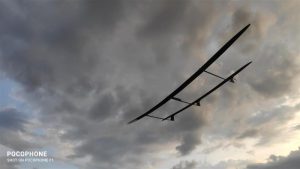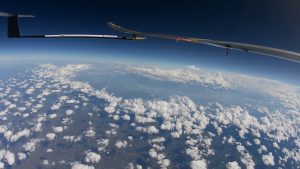The demonstration (pictured) was conducted in Rwandan airspace and delivered 5G connectivity for approximately 73 minutes in the stratosphere, says the company, during which it reached a maximum altitude of 16.9 km. As part of the test, the 5G communications payload enabled a 5G Zoom video call.
Test system
 The test system was composed of a service link from the communications payload installed on ApusDuo in the stratosphere and a feeder link from a 5G base station on the ground.
The test system was composed of a service link from the communications payload installed on ApusDuo in the stratosphere and a feeder link from a 5G base station on the ground.
“Since the radio waves transmitted and received operated on the same frequencies as existing smartphones and devices, a regular 5G smartphone was used in the test,” said the company. “The test also marked Rwanda’s first 5G-based Zoom call.”
The demonstration follows a previous stratospheric flight test conducted in Rwanda in June 2023, during which Mira Aerospace’s ApusDuo carried a dummy version of the payload.
Mira Aerospace – a JV between Bayanat and UAVOS – is based in Abu Dhabi in the United Arab Emirates. The company brings together UAE-based Bayanat’s geospatial AI experience with the U.S.-based UAVOS’ experience in developing unmanned systems.
HAPS
Mira claims the flight as “the world’s first delivery of 5G from a fixed-wing HAPS autonomous aircraft”, but note that Stratospheric Platforms also claimed a world-first 5G demonstration from the stratosphere in 2022.
There are other examples of highflying telecommunications, too.
In July of this year, we also reported on the solar-powered drone built by BAE Warton, also described as a High Altitude Pseudo Satellite (HAPS) Unmanned Aerial System (UAS). It reached 66,000 feet on its 24 hour maiden flight in New Mexico.
Called PHASA-35 the craft had a 115 foot wingspan, weighs 150kg and is powered by batteries at night allowing it to be airborne for several months. It can carry a load of 15kg and applications are seen as environmental surveillance, disaster relief, border protection, maritime and military surveillance, and mobile Internet communications.
And in November 2021 we reported Airbus and NTT Docomo showing that the UK-built solar-powered Zephyr HAPS could deliver wireless broadband connectivity direct to smart phones. Zephyr was conceived, designed and built by Qinetiq in the UK.
See also: Indonesian telco invests in Stratospheric Platforms’ 5G-in-the-sky

